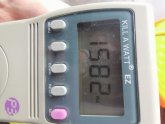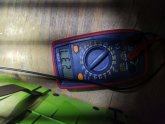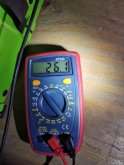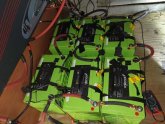Its not clear to me (and I think others) what breaker is tripping. You mentioned your "inverter circuit breaker" trips in the original post and in post #9 you mention the "DC battery output circuit breaker", are you referring to an external circuit breaker tripping, or something built into the inverter? If its external, than as @gnubie said changing your inverter can't fix a shoddy breaker (and will cost a lot more).
You are using an out of date browser. It may not display this or other websites correctly.
You should upgrade or use an alternative browser.
You should upgrade or use an alternative browser.
why is aims/sungoldpower split phase inverter cant supper 1700w continues load?
- Thread starter bluefox140
- Start date
My wife's old hair dryer had a 230 volt switch. If yours does, try running it at 240 volt across line to line. It should pull half the current at the higher voltage and be much easier on the inverter with a balanced load.
How would one go about doing this?
GXMnow
Solar Wizard
- Joined
- Jul 17, 2020
- Messages
- 2,702
If a device has a setting for 220 - 240 volts, you can set it in that mode and wire an outlet from the Phase A and Phase B terminals of the inverter to provide the 240 volt. I do not recommend leaving a normal 120 volt outlet wired that way as the neutral blade will now have 120 volts on it, but for a test it will work just fine. But if someone tries to use that outlet, not knowing it is wired for 240 volt, it could be dangerous. There are proper outlet sockets that are meant for 240 volt, and then you could use a plug adapter for the device you are testing.
Here is a page from Home Depot showing 240 volt US outlets from 20 to 50 amps.
Then you also need the matching plug or adapter to go into it.
Here is a page from Home Depot showing 240 volt US outlets from 20 to 50 amps.
Search Results for 240 volt outlet at The Home Depot
Search Results for 240 volt outlet at The Home Depot
www.homedepot.com
Then you also need the matching plug or adapter to go into it.
bluefox140
New Member
- Joined
- Sep 10, 2020
- Messages
- 87
thank you I will try to see these issues. yes it's very heavy around 80lbsMy point is that you may have excessive voltage drop. So what if your batteries were fully charged? Do you have a loose or not fully-tightened connection? Do you have excessive resistance through the external breaker? If you're seeing a big voltage drop, something is amiss. Either your batteries can't handle it, or there's a loose connection or something. If it's just a breaker on the inverter, I would look at replacing or exchanging the unit before investing over $2K in a Victron (as much as I love them).
Sungold/Signineer/Aims (all the same manufacturer) inverters are generally robust with very high surge capability (was it heavy enough for you when you installed it?), and should be able to deliver the rated output continuously... if the rest of the system can deliver what it needs.
Heavy means big transformer (in a low frequency inverter). Big transformer means big loads and good surge capability. Of course, there are other components that have to be up to snuff to allow the transformer to do its job.
Provided you have sufficient ventilation, your model should handle the continuous rated power fine with a large surge margin, BUT your specific unit may have a manufacturing defect that's prohibiting function. They are made in China, and YOU are their quality control.
Provided you have sufficient ventilation, your model should handle the continuous rated power fine with a large surge margin, BUT your specific unit may have a manufacturing defect that's prohibiting function. They are made in China, and YOU are their quality control.
Still hoping you will clarify which breaker is tripping? (unless I missed it and you already did). Some of the responses you are getting assume its internal some assume its external, and its an important difference.
Still hoping you will clarify which breaker is tripping? (unless I missed it and you already did).
^ This
If there's a breaker ON the inverter, and it's tripping, then it's either the inverter or some other issue (loose connection, excessive resistance/voltage drop). If it's this breaker:
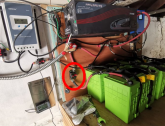
As has been pointed out by Smoov, it's probably the breaker.
^ This
If there's a breaker ON the inverter, and it's tripping, then it's either the inverter or some other issue (loose connection, excessive resistance/voltage drop). If it's this breaker:
View attachment 24159
As has been pointed out by Smoov, it's probably the breaker.
In that case, replacing the breaker (and all the other knockoff breakers in the system) seems like a good first course of action. Bussman is a good brand, there are others, Amazon is not a good place to shop for breakers, their algorithms elevate chinese knock-offs etc--not good for safety equipment. Use a specialized seller that only sells reputable brands and has actual knowledge of the products they sell, waytekwire.com or baymarinesupply.com or altestore.com are some options.
bluefox140
New Member
- Joined
- Sep 10, 2020
- Messages
- 87
after fasten all the bolts in the batteries I was able to run 2 AC plus the hair dryer and drawing around 1850w and 500w without the inverter shutting down. I did it for about 10 mins and I plus in another hair dryer to do the load test that's total of 2800w plus 500w. and the 250a battery circuit breaker jumpped. isn't 250a x 24 should be around 6000w for the breaker to jump? also the starting load volt on the battery is around 26.1 then it will go down to 23.7 and come back stable around 25v as you can see from the photos. any help with why my 250a breaker jumped ?My point is that you may have excessive voltage drop. So what if your batteries were fully charged? Do you have a loose or not fully-tightened connection? Do you have excessive resistance through the external breaker? If you're seeing a big voltage drop, something is amiss. Either your batteries can't handle it, or there's a loose connection or something. If it's just a breaker on the inverter, I would look at replacing or exchanging the unit before investing over $2K in a Victron (as much as I love them).
Sungold/Signineer/Aims (all the same manufacturer) inverters are generally robust with very high surge capability (was it heavy enough for you when you installed it?), and should be able to deliver the rated output continuously... if the rest of the system can deliver what it needs.
thanks in advance
Attachments
bluefox140
New Member
- Joined
- Sep 10, 2020
- Messages
- 87
it was inverter shutting down because of loosen battery terminals. I fasten all of them and it's good now but the 250a battery output breaker will trip at around 3000w. I will get a better breaker and try again. thanks manStill hoping you will clarify which breaker is tripping? (unless I missed it and you already did). Some of the responses you are getting assume its internal some assume its external, and its an important difference.
after fasten all the bolts in the batteries I was able to run 2 AC plus the hair dryer and drawing around 1850w and 500w without the inverter shutting down. I did it for about 10 mins and I plus in another hair dryer to do the load test that's total of 2800w plus 500w. and the 250a battery circuit breaker jumpped. isn't 250a x 24 should be around 6000w for the breaker to jump? also the starting load volt on the battery is around 26.1 then it will go down to 23.7 and come back stable around 25v as you can see from the photos. any help with why my 250a breaker jumped ?
thanks in advance
Starting voltage 26.1 = 3.26V/cell - definitely not fully charged.
Loaded voltage of 23.7 = 2.96V/cell - pretty low.
A 100A load with that voltage drop means you have 24mΩ of system resistance. That's feels pretty high.
I'd repeat the test measuring voltage AT the battery
AND I'd measure voltage across the breaker while you're running the test.
John Frum
Tell me your problems
- Joined
- Nov 30, 2019
- Messages
- 15,233
A low frequency inverter of 6000 watts at 24 volts is a beast.
6000 watts * 1.5 surge capacity and efficiency factor / 24 volts = 375 dc amps
375 dc amps * 1.25 fuse headrooom = 468.75 fuse amps.
You should be using 2x 2/0 awg with 250 amp fuses.
I like these https://www.waytekwire.com/products?pSearch=mrbf&mfg=15&sc=1367&Current-Rating=250A
6000 watts * 1.5 surge capacity and efficiency factor / 24 volts = 375 dc amps
375 dc amps * 1.25 fuse headrooom = 468.75 fuse amps.
You should be using 2x 2/0 awg with 250 amp fuses.
I like these https://www.waytekwire.com/products?pSearch=mrbf&mfg=15&sc=1367&Current-Rating=250A
bluefox140
New Member
- Joined
- Sep 10, 2020
- Messages
- 87
it's not fully charged. it's charged at 35% @26.1v and stable load voltage is around 25.5vStarting voltage 26.1 = 3.26V/cell - definitely not fully charged.
Loaded voltage of 23.7 = 2.96V/cell - pretty low.
A 100A load with that voltage drop means you have 24mΩ of system resistance. That's feels pretty high.
I'd repeat the test measuring voltage AT the battery
AND I'd measure voltage across the breaker while you're running the test.
@blufox140 To the best of my knowledge there is no such thing as a quality 250 amp thermal breaker.
Also even the good breakers are not rated to 60 volts.
Nevermind the voltage I see its a 24 volt system.
A search turned up a few options, two are reputable brands (though not necessarily known for OCP devices) but cost $$$$, and the third is an unknown (to me) brand from a reputable seller (Waytek Wire) but maxes out at 14VDC.
John Frum
Tell me your problems
- Joined
- Nov 30, 2019
- Messages
- 15,233
I always forget about midnite.A search turned up a few options, two are reputable brands (though not necessarily known for OCP devices) but cost $$$$, and the third is an unknown (to me) brand from a reputable seller (Waytek Wire) but maxes out at 14VDC.
Those are panel mount which will be a complication.
Similar threads
- Replies
- 9
- Views
- 586
- Replies
- 1
- Views
- 168
- Replies
- 8
- Views
- 343
- Replies
- 29
- Views
- 953



